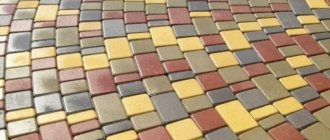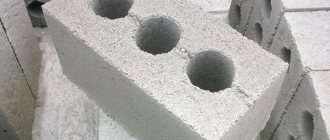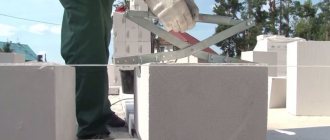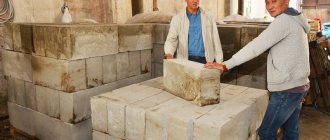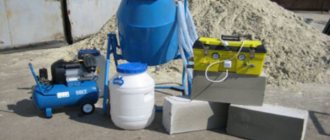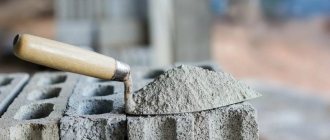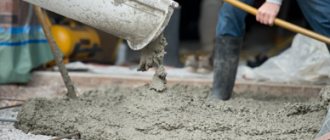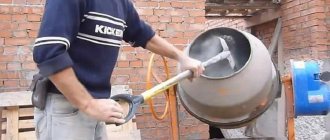Progress does not stand still: a new type of concrete has been developed - geopolymer, in the production of which exclusively natural components are used (although in other countries it has already been used for 50 years). And such building material costs much less than traditional compounds. Some scientists claim that the Egyptian pyramids were made from a mixture of stone chips and a material such as limestone-based geopolymer concrete. Perhaps this is true: it’s not for nothing that they say “the new is the well-forgotten old.”
What is geopolymer concrete made of?
Geopolymer concrete is a material that is considered the most reliable and environmentally friendly today (it’s not for nothing that its name includes the prefix “geo”). The natural components of such concrete are: liquid glass, ash (to be more precise, fly ash or “fly ash”), slag (that is, waste from metallurgical production), water and other binding and fixing components (for example, potassium hydroxide). To produce innovative concrete, which is significantly superior in properties to traditional Portland cement, it is enough to mix all of the specified components in certain proportions.
Liquid glass is an aqueous alkaline solution of sodium or potassium silicates (often also called silicate glue), which is used for the manufacture of acid-resistant cement, fire-resistant paints, wood coatings, and for impregnating fabrics; as well as for gluing cellulose materials.
“Fly ash” is a non-combustible residue in the form of slag resulting from the combustion of plant materials or fuel (it accumulates on the walls). “Fly ash” is a material that is available in abundance in industrial plants and boiler rooms. To obtain geopolymer concrete of the greatest strength, ash is mixed with slag in a 1:1 ratio.
Potassium hydroxide is an inorganic compound that is small, colorless crystals that absorb water well and quickly melt when exposed to oxygen. KOH reacts violently with acids and metals, releasing hydrogen. Due to the fact that this compound is very caustic, it is classified as hazard class 2 (if it comes into contact with the skin and mucous membranes, it causes burns). However, the food industry widely uses potassium hydroxide as an additive E525; It is used in the manufacture of liquid soap and as an electrolyte in alkaline batteries.
History of creation
Geopolymer concrete is called an innovative material. It has become popular in modern construction relatively recently. But it was created back in 1978 by the French scientist Joseph Davidovich.
From the article you can find out how to glue concrete to concrete.
The chemist got the idea for creating the material from nature itself: he noticed that some components of geological origin polymerize when interacting with an alkaline environment. As a result of experiments in this direction, a material was born that scientists called geopolymer. It is still known by this name today.
Video shows geopolymer concrete:
Davidovich believed that monolithic construction technology was used during the construction of individual pyramids in Giza. The scientist managed to determine the composition of the monolithic blocks of the pyramids.
His theory is still disputed. Be that as it may, one cannot deny the fact that geopolymer concrete is a durable material with excellent qualities. And it is increasingly used in modern construction.
Concrete wall blocks dimensions and other characteristics can be read from the article.
Advantages of geopolymer concrete
This material has the following advantages:
- has a small specific gravity;
- low content of toxic substances;
- resistant to corrosion, cracking, high and low temperatures;
- is non-flammable;
- has high compressive strength;
- the ability to quickly gain the greatest strength in a short period;
- has low thermal conductivity;
- characterized by low shrinkage (that is, immediately after completion of construction you can begin finishing work);
- resistant to chemicals;
- hardening speed is 3 times higher than that of traditional concrete;
- low vapor permeability;
- greenhouse gas emissions are minimal;
- ecologically pure;
- durable;
- low cost of material components;
- easy to process.
Areas of use
Widely used in construction. Various lightweight and load-bearing structures are constructed from geopolymer. The strength and characteristics of the material make it possible to make walls thinner. The material can be used in both low-rise and high-rise construction. Excellent for the construction of residential and public buildings.
Natural materials help create a comfortable indoor microclimate. Sometimes used for finishing the interior or exterior of buildings. Less commonly, geopolymers are used to create decorative elements: plant vases, statues and other decorations.
Self-production of geopolymer concrete
Scientists have not yet announced the final official “verdict” regarding the exact proportions of the components of the “concrete of the future”, since research in this area is still ongoing. Many people try to determine the optimal proportions of material components by “trial and error” and make geopolymer concrete with their own hands. Why not, especially since everything needed to make the “material of the future” is on sale.
The solution (volume 10 l) includes the following ingredients:
- potassium hydroxide (1600 g) - KOH;
- 60% liquid glass (2000 g) – K₂O(SiO₂);
- ash (5500 g) - “fly ash”;
- slag (5500 g);
- water (1 l).
To prepare concrete from these components, you will need:
- a container in which all components are mixed (it is better if the material of the container is resistant to elevated temperatures) or a concrete mixer (for large volumes);
- scales, since compliance with all proportions is extremely important;
- gown, hat, goggles, gloves and respirator (that is, personal protective equipment);
- the form or formwork into which you plan to pour the prepared mixture;
- wooden spatula for mixing, since wood is neutral to alkalis (this is important).
Manufacturers
Not everyone likes experiments. And in the case of geopolymer concrete, it is easier to buy a ready-made mixture than to prepare construction concrete.
In 2012, industrial production of geopolymer concrete based on slag and fly ash was launched.
Consumers are offered the following grades of concrete:
- M50-M500 (in terms of strength);
- W2-W12 (waterproof);
- F50-F300 (for frost resistance).
The price of this material depends on the proportions and quantities of all components. Cement is sold in the form of a dry mixture without a hardener.
From the article you can find out which is better: foam concrete, aerated concrete or cinder blocks.
Russian manufacturers
- Eurocement Group. The largest cement production company. The headquarters is located in Moscow. The company produces its products at 19 factories and 36 branches in Russia, Ukraine and Kazakhstan. The manufacturer offers high-quality concrete. All production is automated. Geopolymer concrete is produced in computerized concrete units. The price of one bag of dry mixture without hardener is from 190 rubles.
- "Sebryakovcement". City-forming enterprise in the city of Mikhailovka, Volgograd region. The company independently sells its own products. The company enters into direct contracts with consumers. Concrete mixtures and other products of the manufacturer are celebrated annually at exhibitions. For several years in a row, the company has won the title “Quality Leader”. The price of its products corresponds to the quality. The cost of a bag of geopolymer concrete is 175 rubles.
- "Stone Flower". The brand is represented on the market with universal, masonry and plaster mixtures. Sand concrete of this brand is in high demand. It consists of cement grades PTs 400D0, PTs 500D0 and fractionated sand. As for prices, they are quite affordable and depend on the volume of purchase. A bag of geopolymer concrete can be bought for 180 rubles.
European stamps
- LAFARGE (France). The world's largest producer of cement and concrete mixtures. Has representative offices in Russia. These are factories in the Moscow (Voskresenskcement) and Chelyabinsk regions (Uralcement). It specializes in the production of not only cement, but also non-metallic materials and concrete. From this manufacturer, a bag of geopolymer concrete costs from 220 rubles.
- GRUPOSUBDI (Spain). The products are of high quality. The company offers dry mixes in bags for sale at a price of 215 rubles.
- Heidelberger Cement. A world-famous manufacturer of ready-mixed concrete. The most daring engineering ideas become reality with concrete of this brand. You can buy products at a price of 230 rubles. per bag.
Geopolymer concrete is an excellent material for solving a wide variety of construction problems. He is the future. In just a few years, it has managed to establish itself well on construction sites of all levels. A significant advantage of the material is the creation of a smooth surface, the strength of which increases over time. But that's not all. Geopolymer concrete helps solve another, no less important problem. We are talking about waste disposal. This type of concrete allows you to create monoliths of various shapes without harming the environment.
Mixture preparation technology
The technology for preparing the solution is quite simple: you just need to strictly follow all the recommendations.
General requirements
It is important:
- the humidity of the room in which you mix the concrete components should be low (so that potassium hydroxide does not “float”);
- Potassium hydroxide must be stored in a sealed package, eliminating any possibility of liquid getting into it;
- open the package immediately before mixing;
- all work related to potassium hydroxide and liquid glass should be carried out wearing personal protective equipment to avoid burns to the skin and mucous membranes of the eyes (since KOH is an extremely aggressive substance);
- Knead quickly but carefully.
Process of mixing and making concrete
If you use a concrete mixer, then the work algorithm is as follows:
- Pour in warm water.
- Add slag and ash, mix everything thoroughly.
Advice! If the goal is to obtain durable concrete, then only “fly ash” can be used; and if it is more important to produce an environmentally friendly material, then the ash content can be reduced and the missing amount replaced with cement.
- Add polymers and mix again.
- Pour the mixture into the mold or formwork.
Advice! To speed up the hardening process, you can place special electrodes in the formwork and, after pouring the solution, pass current through them for 1 hour. Moreover, electricity must not be taken from the network directly, but a converter must be used.
